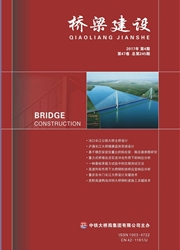

 中文摘要:
中文摘要:
为了解新型大纵肋钢-超高性能混凝土(UHPC)正交异性组合桥面板对传统正交异性钢桥面板的受力性能的改善效果,以港珠澳大桥深水区非通航孔6×110m连续钢箱梁桥为背景,建立全桥有限元模型,对2种桥面方案的静力性能进行对比,建立节段有限元模型,对比2种桥面方案U肋与顶板连接焊缝处的疲劳性能,并分析U肋开口宽度和UHPC结构层厚度对大纵肋钢-UHPC正交异性组合桥面板疲劳性能的影响。结果表明:2种桥面方案下钢箱梁控制点的位移和应力相差不大,所提出的大纵肋钢-UHPC正交异性组合桥面板在中等跨度连续梁桥中具有较好的适用性;大纵肋钢-UHPC正交异性组合桥面板的疲劳性能显著优于传统正交异性钢桥面板;增大U肋开口宽度会导致U肋与顶板连接焊缝应力幅增加,增加UHPC结构层厚度能显著降低U肋与顶板连接焊缝应力幅。
 英文摘要:
英文摘要:
To understand the improvement on the mechanical behavior of the traditional ortho-tropic steel bridge deck by utilizing the new type of the steel and ultra-high performance concrete (UHPC) orthotropic composite bridge deck with the large longitudinal U ribs, the 6X100-m con-tinuous steel box girder bridge of the non-navigable spans of the Hong Kong-Zhuhai-Macao Bridge over the deep water area was cited as an example, the finite element model for the whole bridge of the steel box girder bridge was established and the static behavior of the two kinds of the tradition-al and composite bridge decks was compared. The segment finite element model was also estab-lished, the fatigue behavior of the welded joints connecting the U ribs and top plates of the two decks was compared and the influences of the opening width of the U ribs and the thickness of the UHPC structural layers on the fatigue behavior of the composite bridge deck were analyzed. The results indelicate that for the two kinds of the decks, the displacement and stresses of the control points of the steel box girders do not differ greatly, the composite bridge deck has good applicabili ty to the continuous girder bridges of medium spans and the fatigue behavior of the compositebridge deck is significantly superior to the traditional one. The increase of the opening width of the U ribs can cause the stress ranges of the welded joints connecting the U ribs and the top plates to increase,however, the increase of the thickness of the UHPC structural layers will significantly decrease the stress ranges of the welded joints.
 同期刊论文项目
同期刊论文项目
 同项目期刊论文
同项目期刊论文
 期刊信息
期刊信息
